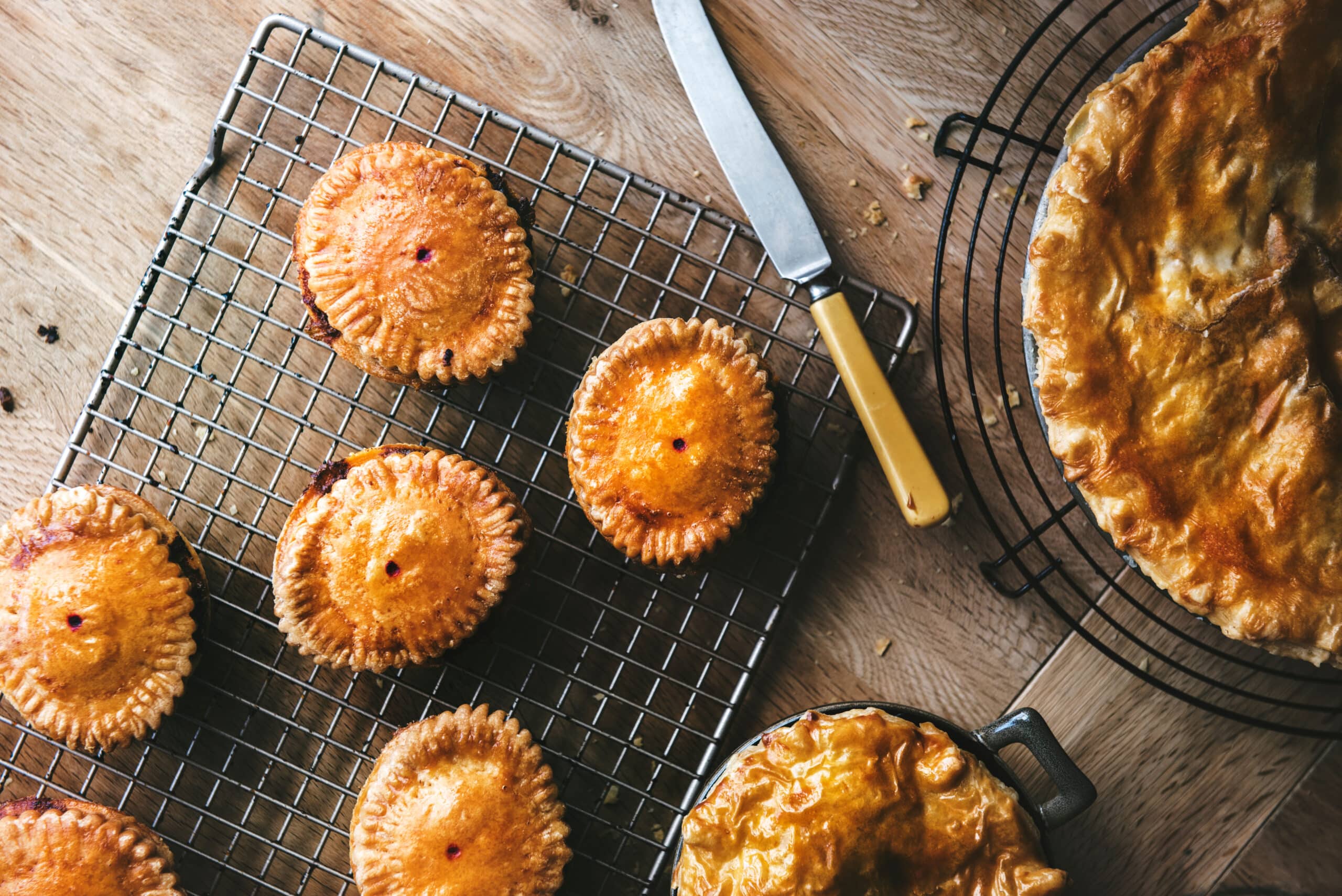![]()

![]()

A beef and oyster pie may sound like an obscure recipe written into a Dickensian novel and I’ve no doubt somewhere in the backlog of novels it probably is. It was once a staple in British kitchens, particularly during the 17th and 18th centuries, when oysters were plentiful and cheap. It is a relic of days gone by, imagine walking through the streets of London in the 1700s. Oysters were sold by street vendors, piled high in baskets, and were a food of the people. Unlike today, when oysters are considered a luxury, they were once one of the most affordable sources of protein, especially in port cities where the oyster trade flourished. In fact, oysters were so abundant in coastal areas that they were often combined with other ingredients—like beef—to make hearty meals that were both filling and affordable.
Beef, on the other hand, has long been a staple of British diets although considered more a luxury in the 17th & 18th centuries. The country’s rich pasturelands made cattle farming common, and beef was a favoured meat for those that could afford it in abundance for its versatility and rich flavour. The tradition of pies on our shores, too, goes back centuries, with savoury fillings wrapped in pastry providing not only a delicious meal but also a practical way to preserve and store food for longer periods. Pies became a reliable dish, and the combination of beef and oysters was one of the more intriguing and resourceful variations.

In those days, beef and oyster pie wasn’t reserved for special occasions or upper-class households. It was a dish for the everyday family, a reflection of the creativity cooks employed to stretch their resources. Oysters, with their briny, slightly sweet flavour, were the perfect contrast to the rich, robust taste of beef. It was a balance of land and sea, creating a dish that was both comforting and full of flavour. And since oysters were readily available in large quantities, especially around cities like London and Bristol, it made sense to add them to a dish like beef pie, turning it into a more substantial meal. In fact a mark of wealth would often be the ratio of beef to oyster, a higher quantity of beef to oyster generally meant you had a bit more money to afford the more premium ingredient beef!
The pie also had a symbolic weight. Britain, as an island nation, has always had a close relationship with the sea. The pairing of beef and oysters represented this connection rather like our surf and turf in a proper pub does today, bringing together the best of what the land and sea could provide. It was a dish that fed not only the working class but also made appearances in more lavish settings. At grand banquets, beef and oyster pie could be decorated with intricate pastry designs, elevating it to a centrepiece dish.
As the 19th century rolled in, the story of beef and oyster pie began to change. Industrialization altered the economy, and with that, the availability of certain ingredients. Oysters, once abundant, became scarcer and more expensive due to over-harvesting and pollution in key oyster beds like those of the Thames Estuary. What was once an affordable food for the masses became a luxury, and the pairing of beef and oysters started to disappear from everyday kitchens. The pie faded into history, remembered fondly but cooked less frequently.
But in the here and now is there a place once again for a recipe that was once consigned to the history books? With a growing focus on sustainability, carbon footprints and an understanding that resources aren’t limitless could now be the time we see resourceful dishes adopted by our ancestors given a new lease of life. Oyster are definitely making a resurgence, especially as they are the ultimate sustainable ingredients with zero chemicals or feed, the ability to clean and filter our waters and being a means of carbon capture. The industrialised farming of cattle on the other hand has the opposite effect and there is a clear emphasis on eating less intense foods. One may believe that a beef an oyster pie is a form of ‘offset’ it’s not perfect but it is a compromise. Less beef, more oyster and you have mitigate and made a small contribution to carbon reduction. Tenuous maybe but on a large scale these small alterations make a big difference.
As I write this article, Ollie is on version four of the pie, something that hasn’t been cooked and well documented for so long take time to perfect, and perfect we will. At this point I’ll be saving this to draft format and probably helping wash some pie trays. But for you the final recipe will follow just down the page! Voila!!!I
Serves:4
Cooks in: 120 minutes
Difficulty: HARD
Ingredients
For the Filling:
500g of chuck steak, diced
1 carrot
8 Maldon oysters
250g shallots
garlic
Plain flour
440ml can of Unbarred x Faber Oyster Stour
1 tsp cyder vinegar
2 tsp wild honey
50g wholegrain mustard
2 bay leaves
Rosemary & Thyme sprigs
Sea salt
Black pepper
For the Pastry:
600g of plain flour
200g of butter
200g of suet, shredded
Sea salt
iced water
1 egg
Process
Get everything prepared. Chop the carrots into chunks, peel and half the shallots, peel then crush garlic and finely shop the herbs.
Add the garlic, carrots and shallots to a cast iron casserole and colour over a hob on medium heat. Dust the meat with the flour and season with salt & pepper, add it to the vegetables, stirring until nicely browned all over. Immediately pour in the stout, cyder vinegar, mustard and finely chopped herbs. If the meat isn’t covered by the liquid, add some water or extra stout until it’s just covered. Bring to the boil then remove from hob. Put on the casserole dish lid and place in the oven for 3 hours at 160 degrees.
For the pastry lid, combine the flour, butter, suet and salt in a large mixing bowl and use your fingers to rub the butter into the flour. Keep on doing this until the mixture resembles breadcrumbs. Pour in the water and start pressing the liquid into the breadcrumb-like mixture. Don’t be too rough as you must not overwork the dough. Allow the dough to rest by wrappign in cing film and leaving in fridge for an hour minimum.
Now shuck your oysters (we have a useful guide here, but be careful and make sure you use the correct knife, you’ll be surprised how many injuries were caused in lockdowns with screwdrivers used as shucking knives), place the oysters in a bowl and drain off the majority of the brine.
Lightly grease your pie dish and then roll out three quarters of the pastry and thinly line the dish. Add your warm beef mix by ladling into the centre of the pie and make sure it is three quarters full. Place the shucked oysters in the pie on top of the beed mix gently and evenly spread, then dirzzle the wild honey lighly across the top of the oysters and beef mix. Gently brush some egg wash around the top rim of the pie.
Take the remainder roll out to a 1cm thickness, making sure it’s slightly larger than your pie lid. Gently drape the lid centred over the pie, cut to size around the dish and then use a fork or your fingers to crimp the pie tighlt closed. Season the top of your pie with cracked black pepper (we use a dried seaweed mix of nori and pepper dulse). Place the whole pie in the over at 160 degrees for 45 minutes, only removing when the lid of the pie is a golden brown.
And I was right! The oyster pie is entioned in Charles Dicken’s novel, The Pickwick Papers!
Here are eight simple yet delicious dressings that pair perfectly with fresh oysters, each designed to complement their natural flavour without overwhelming it.
Read moreThis year, why not surprise your guests with these five exquisite seafood-inspired recipes that are as celebratory as they are delicious?
Read moreAlcohol free cocktails made for all tastes and still using British coastal ingredients.
Read more
